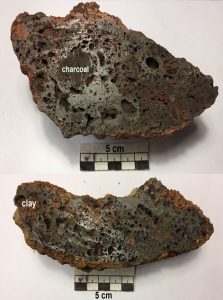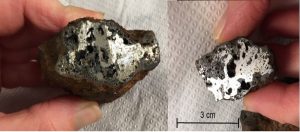
Several samples of metallurgical slags and some metallic fragments have been found during the last excavation campaignat Vetricella (Scarlino). The analysis of these materials (metallography, chemistry and mineralogy) can help to define what type of metal production/working was conducted in the site. Moreover the distribution of metallurgical wastes could identify the areas devoted to smithing/smelting, which will be the target of next excavations. All these analysis will be performed at the Department of Earth Sciences, University of Florence.
As evidenced during the previous surface surveys most slags are of the typical plano-convex type, and are presumably the waste of iron smelting (Fig. 1).
Evidence of this activity at Vetricella (Scarlino) is also provided by other findings, including several iron bars and one piece of iron bloom (partly forged?) discovered among smelting slags (Fig. 2). Given the occurrence of (up to now) scanty pieces of hematite-rich iron ore and tapped slag, we cannot rule out the hypothesis that iron smelting was also practiced at Vetricella. Specific mineralogical and trace element analysis could allow us to establish if the pieces of iron ore might come from Elba Island, the most important source of iron in Antiquity in the whole Mediterranean area.

Many well-preserved Ag-Cu coins have also been found during 2016 excavations. They date to the 9th-11th cent. AD and, upon preliminary numismatic analysis (by A. Rovelli and C. Cicali) they were issued from different Italian mints. Some of these coins have been selected for lead isotope analyses in order to establish metal sources for coinage in the period of interest, and, in particular, the role played by the Colline Metallifere copper/silver ores.


